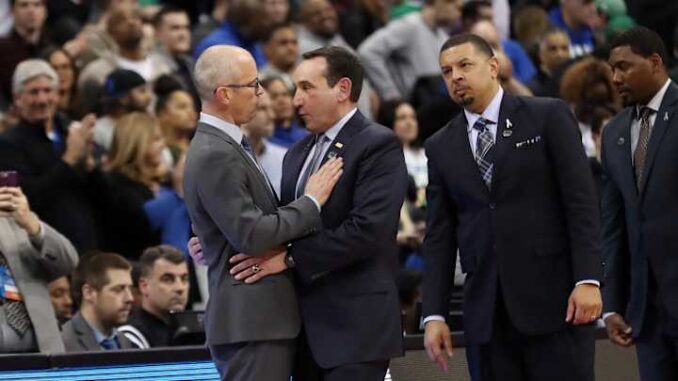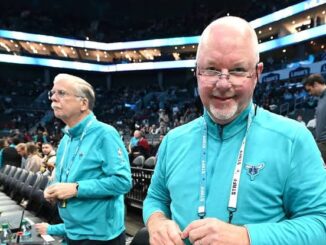
UConn’s Dan Hurley Weighs in on Coach K’s Ambitious ACC-Big East Merger Idea…
In the world of college basketball, few voices carry as much weight as that of Duke legend Coach Mike Krzyzewski. Recently, Krzyzewski made waves by suggesting a potential merger between the ACC (Atlantic Coast Conference) and the Big East Conference, a groundbreaking idea that has captured the attention of fans, players, and coaches alike. Among those to weigh in on this bold proposal is UConn’s head coach Dan Hurley, a figure whose leadership has transformed the UConn men’s basketball program since he took the helm in 2018.
In an exclusive interview, Hurley shared his thoughts on Coach K’s ambitious vision, providing a unique perspective as a coach in a prominent program that sits at the crossroads of both conferences. Hurley, whose team is a member of the Big East, offered insight into how this merger might impact college basketball, especially in terms of competition, revenue, and the overall landscape of college sports.
“I think Coach K’s idea is certainly thought-provoking,” Hurley began. “The Big East and ACC have always been powerhouses in their own right, but combining them could create an absolutely monstrous league in terms of competition and exposure. There are so many storylines, rivalries, and potential matchups that could make college basketball even more exciting.”
Coach K’s proposal centers around the notion of a conference merger that would effectively combine the resources, talent pools, and media rights of the ACC and Big East to form a superconference capable of competing with the mega-conferences, such as the SEC and Big Ten, which have continued to grow their footprint in recent years. The idea stems from a need to keep college basketball competitive in an evolving sports landscape dominated by football, while also addressing the issue of conference realignment and the growing power of the larger football-centric conferences.
Hurley, who is known for his passion and intense focus on building competitive teams, explained that the benefits of such a merger would be far-reaching. “You’d have an incredible blend of programs — from Duke, North Carolina, and Virginia in the ACC to UConn, Villanova, and Creighton in the Big East,” Hurley said. “It would elevate the level of play across the board and increase the national interest in games every single night.”
One of the biggest advantages Hurley sees in this proposal is the increased exposure and media coverage it would bring to both conferences. With the power of media rights and a larger conference footprint, teams would be able to garner more television time, thus improving their chances of recruiting top talent from across the country. Hurley also pointed out that it could open the door to more lucrative opportunities for NCAA tournament seeding and increased participation in March Madness, a boon for all teams involved.
However, Hurley also expressed caution. The logistics of a merger, especially one of this magnitude, could present challenges that may not be immediately apparent. One concern he raised was the balance between basketball and football, with the two sports requiring very different levels of commitment and infrastructure. The ACC, with its deep-rooted football programs, and the Big East, known for its basketball legacy, would have to find a way to balance these differing priorities.
“I think it’s a great idea in theory, but the execution would be tricky,” Hurley said. “Basketball thrives in a unique way compared to football, so it would require a lot of planning to make sure both sports get the resources and attention they deserve.”
Moreover, the integration of schedules, travel logistics, and competitive balance could pose significant hurdles for coaches, players, and administrators. “There’s a lot of overlap in terms of the region these programs span,” Hurley acknowledged. “It could make scheduling even more intense, especially for teams in the northeastern part of the country. Travel could become grueling, and we would need to ensure that the student-athletes’ academic commitments are not compromised.”
Despite these concerns, Hurley emphasized that the potential upside of such a merger cannot be overlooked. “There’s a lot to gain, but it would take time to iron out all the details. The idea of a more unified and competitive landscape is definitely exciting for the future of college basketball.”
While Coach K’s proposal is still in its infancy and unlikely to materialize soon, Hurley’s reflections on the idea highlight the intrigue and complexities that come with such a bold move in the ever-evolving world of college athletics. Whether or not this merger becomes a reality, it’s clear that discussions like these are shaping the future of college basketball in ways that no one could have predicted just a few years ago.



Be the first to comment